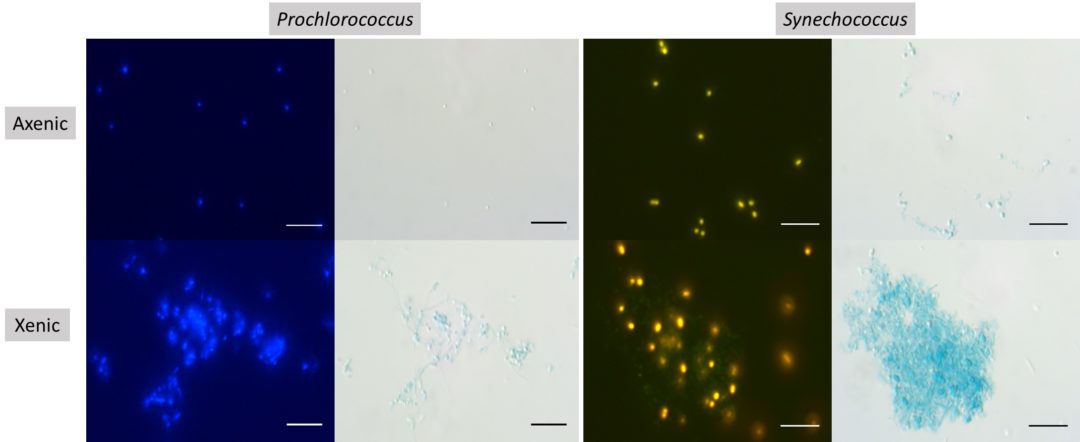Epifluorescence and corresponding brightfield photomicrographs of Alcian Blue stained cultures of Prochlorococcus in axenic and xenic conditions, as well as Synechococcus in axenic, and xenic conditions. Scale bars are 10 mm. (Cruz and Neuer, 2019)
The oceanic biological carbon pump (BCP) is the biologically-mediated way by which the oceans transform dissolved inorganic carbon into particulate and dissolved organic carbon, as well as subsequently export to depth. The traditional view of the BCP is the export of organic carbon by the settling of zooplankton fecal pellets and aggregates of large, mineral-ballasted phytoplankton cells — such as diatoms and coccolithophores; however, recent in-situ evidence have shown that picophytoplankton (0.2-2μm in size) may also contribute significantly to the export of particulate organic matter.
In a current NSF-funded project “Marine Picoplankton Aggregation”, the Neuer lab investigates the specific mechanisms of aggregation of these pico-sized cells — which have been previously thought to be too small to sink. This work combines experiments both in the laboratory as well as at the Bermuda Atlantic Time Series station BATS in the Sargasso Sea, and builds there on our previous work within the NSF-funded Trophic BATS project.
This research also builds on previous work by Deng et al. (2015, 2016) in the Neuer lab who showed the ability of the ubiquitous marine picocyanobacteria Synechococcus to form aggregates and sink at velocities comparable to those of marine snow, especially with the addition of clay minerals. This earlier work was part of the ASU Astrobiology Institute with the goal to investigate the potential mechanisms of carbon export in the early, Proterozoic ocean.
To learn more about this project, see this news post on ASU Now.
References:
Cruz B.N., S. Brozak, and S. Neuer. Optical and DNA-based characterization of sinking particles at the Bermuda Atlantic Time-series Study (BATS) station, in preparation
Cruz B.N., and S. Neuer. 2019. Heterotrophic bacteria enhance the aggregation of the marine picocyanobacteria Prochlorococcus and Synechococcus. Frontiers in Microbiology, 10, 1864, doi.org/10.3389/fmicb.2019.01864
Deng W., B.N. Cruz and S. Neuer. 2016. Effects of nutrient limitation on cell growth, TEP production and aggregate formation of marine Synechococcus. Aquatic Microbial Ecology, 78, 39-49, doi.org/10.3354/ame01803
Deng W., L. Monks and S. Neuer. 2015. Effects of clay minerals on the aggregation and subsequent settling of marine Synechococcus. Limnology and Oceanography, 60, 805-816, doi: 10.1002/lno.10059

